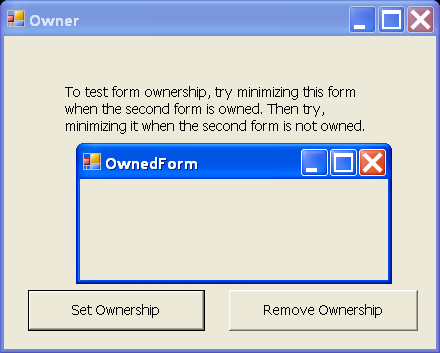Form Ownership

/*
User Interfaces in C#: Windows Forms and Custom Controls
by Matthew MacDonald
Publisher: Apress
ISBN: 1590590457
*/
using System;
using System.Drawing;
using System.Collections;
using System.ComponentModel;
using System.Windows.Forms;
namespace FormOwnership
{
/// <summary>
/// Summary description for Owner.
/// </summary>
public class Owner : System.Windows.Forms.Form
{
internal System.Windows.Forms.Button cmdReleaseOwnership;
internal System.Windows.Forms.Button cmdAddOwnership;
private System.Windows.Forms.Label label1;
/// <summary>
/// Required designer variable.
/// </summary>
private System.ComponentModel.Container components = null;
public Owner()
{
//
// Required for Windows Form Designer support
//
InitializeComponent();
//
// TODO: Add any constructor code after InitializeComponent call
//
}
/// <summary>
/// Clean up any resources being used.
/// </summary>
protected override void Dispose( bool disposing )
{
if( disposing )
{
if(components != null)
{
components.Dispose();
}
}
base.Dispose( disposing );
}
#region Windows Form Designer generated code
/// <summary>
/// Required method for Designer support - do not modify
/// the contents of this method with the code editor.
/// </summary>
private void InitializeComponent()
{
this.cmdReleaseOwnership = new System.Windows.Forms.Button();
this.cmdAddOwnership = new System.Windows.Forms.Button();
this.label1 = new System.Windows.Forms.Label();
this.SuspendLayout();
//
// cmdReleaseOwnership
//
this.cmdReleaseOwnership.FlatStyle = System.Windows.Forms.FlatStyle.System;
this.cmdReleaseOwnership.Location = new System.Drawing.Point(152, 196);
this.cmdReleaseOwnership.Name = "cmdReleaseOwnership";
this.cmdReleaseOwnership.Size = new System.Drawing.Size(128, 32);
this.cmdReleaseOwnership.TabIndex = 3;
this.cmdReleaseOwnership.Text = "Remove Ownership";
this.cmdReleaseOwnership.Click += new System.EventHandler(this.cmdReleaseOwnership_Click);
//
// cmdAddOwnership
//
this.cmdAddOwnership.FlatStyle = System.Windows.Forms.FlatStyle.System;
this.cmdAddOwnership.Location = new System.Drawing.Point(16, 196);
this.cmdAddOwnership.Name = "cmdAddOwnership";
this.cmdAddOwnership.Size = new System.Drawing.Size(120, 32);
this.cmdAddOwnership.TabIndex = 2;
this.cmdAddOwnership.Text = "Set Ownership";
this.cmdAddOwnership.Click += new System.EventHandler(this.cmdAddOwnership_Click);
//
// label1
//
this.label1.Location = new System.Drawing.Point(40, 36);
this.label1.Name = "label1";
this.label1.Size = new System.Drawing.Size(216, 80);
this.label1.TabIndex = 4;
this.label1.Text = "To test form ownership, try minimizing this form when the second form is owned. T" +
"hen try, minimizing it when the second form is not owned.";
//
// Owner
//
this.AutoScaleBaseSize = new System.Drawing.Size(5, 14);
this.ClientSize = new System.Drawing.Size(292, 242);
this.Controls.AddRange(new System.Windows.Forms.Control[] {
this.label1,
this.cmdReleaseOwnership,
this.cmdAddOwnership});
this.Font = new System.Drawing.Font("Tahoma", 8.25F, System.Drawing.FontStyle.Regular, System.Drawing.GraphicsUnit.Point, ((System.Byte)(0)));
this.Name = "Owner";
this.StartPosition = System.Windows.Forms.FormStartPosition.CenterScreen;
this.Text = "Owner";
this.Load += new System.EventHandler(this.Owner_Load);
this.ResumeLayout(false);
}
#endregion
private OwnedForm frmOwned = new OwnedForm();
private void Owner_Load(object sender, System.EventArgs e)
{
this.Show();
frmOwned.Show();
}
private void cmdAddOwnership_Click(object sender, System.EventArgs e)
{
this.AddOwnedForm(frmOwned);
frmOwned.lblState.Text = "I'm Owned";
}
private void cmdReleaseOwnership_Click(object sender, System.EventArgs e)
{
this.RemoveOwnedForm(frmOwned);
frmOwned.lblState.Text = "I'm Free!";
}
[STAThread]
static void Main()
{
Application.Run(new Owner());
}
}
/// <summary>
/// Summary description for OwnedForm.
/// </summary>
public class OwnedForm : System.Windows.Forms.Form
{
public System.Windows.Forms.Label lblState;
/// <summary>
/// Required designer variable.
/// </summary>
private System.ComponentModel.Container components = null;
public OwnedForm()
{
//
// Required for Windows Form Designer support
//
InitializeComponent();
//
// TODO: Add any constructor code after InitializeComponent call
//
}
/// <summary>
/// Clean up any resources being used.
/// </summary>
protected override void Dispose( bool disposing )
{
if( disposing )
{
if(components != null)
{
components.Dispose();
}
}
base.Dispose( disposing );
}
#region Windows Form Designer generated code
/// <summary>
/// Required method for Designer support - do not modify
/// the contents of this method with the code editor.
/// </summary>
private void InitializeComponent()
{
this.lblState = new System.Windows.Forms.Label();
this.SuspendLayout();
//
// lblState
//
this.lblState.Location = new System.Drawing.Point(8, 8);
this.lblState.Name = "lblState";
this.lblState.Size = new System.Drawing.Size(184, 56);
this.lblState.TabIndex = 1;
//
// OwnedForm
//
this.AutoScaleBaseSize = new System.Drawing.Size(5, 14);
this.ClientSize = new System.Drawing.Size(208, 78);
this.Controls.AddRange(new System.Windows.Forms.Control[] {
this.lblState});
this.Font = new System.Drawing.Font("Tahoma", 8.25F, System.Drawing.FontStyle.Regular, System.Drawing.GraphicsUnit.Point, ((System.Byte)(0)));
this.Name = "OwnedForm";
this.StartPosition = System.Windows.Forms.FormStartPosition.Manual;
this.Text = "OwnedForm";
this.ResumeLayout(false);
}
#endregion
}
}
Related examples in the same category